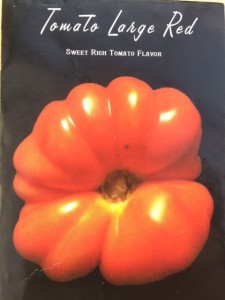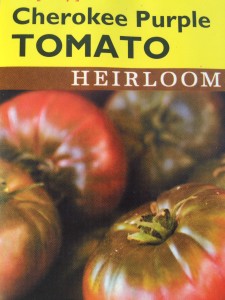SOME GREAT HEIRLOOM TOMATOES
Tomatoes are native to the Andes Mountain region, a region of varied climates. The kind of tomatoes most frequently grown in our gardens are botanically classified as Lycopersicon esculentum. Tomatoes are easy to grow in Western Montana if given the right conditions in the garden. The site should be sunny and protected from wind, but with some airflow. If grown in too close or crowded conditions tomatoes can succumb to disease. Fortunately, in our area, the air is usually pretty dry, meaning humidity is usually low (when the sun is out). Good soil is important. I amend my existing soil with manure, bone meal or rock phosphate, alfalfa meal or wood ashes and greensand. A good, dark compost will enrich your soil, feed the tomatoes and retain moisture. If you prepare your soil well, as organic gardeners do, you will not have to feed them at all the rest of the season. Tomatoes prefer even moisture; if given too little water they will produce fewer and smaller fruit. If given too much water all at once, especially when the soil has dried out, the fruit often crack and split. An even, slow watering is best, so the moisture goes deep into the soil. Leaf roll, blossom-end rot and cracked fruit can be prevented by careful, even watering—aim for moist soil always, not wet or dry.
Tomatoes are naturally a vining plant, though they have been selected over the centuries to be shorter and bushier. This is especially true of more recent seed strains. Many of the oldest heirloom tomatoes are tall plants that require support in the form of a tomato cage or wooden frame, or a trellis. One example of a tall heirloom tomato is ‘Purple Cherokee’, which grows over six feet tall! It is important to keep the fruit off the ground and leave space around your plants. This will help prevent disease. It is best to water tomatoes in the morning and avoid wetting foliage in the evening. This will reduce or prevent late blight (spots on leaves and fruit). Other diseases include: powdery mildew, verticillium wilt, and fusarium wilt. If you suspect disease, your county extension agent or other specialist can help you diagnose these problems and recommend remedies. This is important in our region, to protect our potato industry. Potatoes are related to tomatoes and subject to many of the same diseases. Sulfur and copper fungicides are two available OMRI listed, certified organic disease controls.
Deer are a primary pest in our gardens; gophers and voles are quite damaging, too. A tall (seven foot) fence helps prevent deer, and hardware cloth under a raised bed is a good way to prevent gophers and voles.
One more issue to watch is proper pollination of your tomatoes. Fruit will not set well if daily high temperatures do not reach 55 degrees; conversely, fruit will not set if temperatures are over 100 degrees. Historically, we have had troubles setting fruit with our cold days and nights, but nowadays with warming temperatures, the daily high temperatures might become an issue.
Here is a list of some wonderful open-pollinated heirloom tomatoes that do not have too late a season for Western Montana:
‘Glacier’ (55 days) is a dwarf, bushy variety with potato-like leaves. The fruit are 2” to 3” and red to orange. ‘Glacier’ produces well in cool climates and has excellent flavor for an early tomato. No pruning or staking is needed for this variety.
‘Bison’ (65 days) was developed in North Dakota in 1937. It is another dwarf variety that sets 3” deep red tomatoes even in cool weather. ‘Bison’ can produce as much as 40 pounds of tomatoes from one plant. This variety requires no staking or pruning.
‘Persimmon’ is an orange, persimmon-colored tomato that originated in Massachusetts in the mid-1800s. It is rare today and reasonably early, (75 to 80 days). The flavor is very good, low-acid; the fruit reaches about one pound. This is a great tomato for salsa!
‘Large Red’ (80 days) is one of the oldest and rarest tomatoes. It originated in Massachusetts, in the 1820s, and was grown by the Shakers. Pioneers brought is west on the Oregon Trail. It is a tall plant with convoluted red fruit resembling the pumpkin that became Cinderella’s coach. 12 oz. fruit is common, as it is a beefsteak-type. ‘Large Red’ has a sweet and rich flavor.
‘White Shah’ (80 days) is an heirloom from the 1880s; a very mild, flavorful, white tomato. The fruit are quite large, 8-12 ounces, and the plants have potato-like leaves. ‘White Shah’ was the healthiest tomato I grew last year, and one of the best for flavor.
‘Pink Brandywine’ (80 days) is another tall plant, potato-leaved, with delicious, pink fruit. It is the most popular heirloom for flavor, though the plants are more disease-prone than most tomatoes. Good culture should prevent or minimize these problems. ‘Pink Brandywine’ is one of the best for tomato sauce.
‘Cherokee Purple’ (80 days) originated with the Cherokee people and was brought west to Oklahoma on the Trail of Tears. The plant is very tall—six to seven feet! Staking and/or caging is necessary. The fruit are large, flavor is among the very best, and fruit sets fairly early. Prepare your soil well, as this variety is not usually as productive as some.


